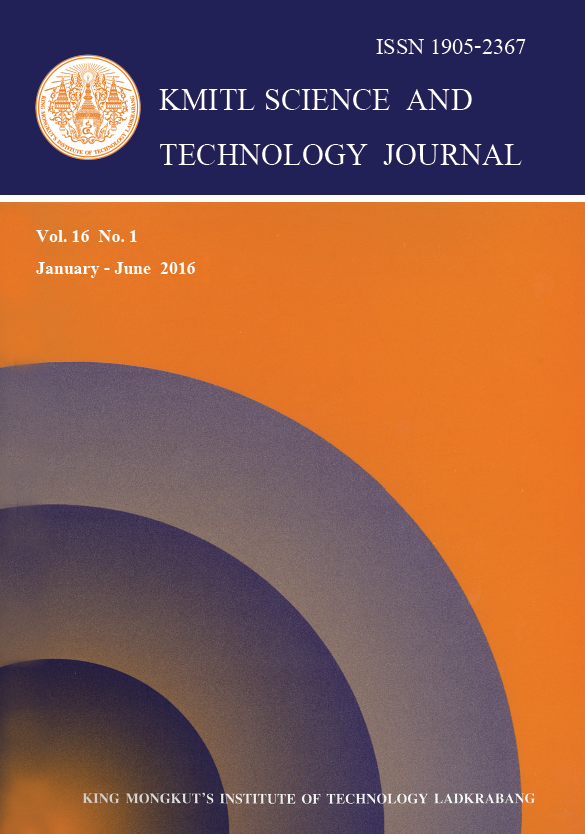Microstructural Effects of Pre-aged Stainless Steels on Carbon Nanotubes Growth
Main Article Content
Abstract
Catalytic roles of precipitates inside the 316L stainless steel (SS) were investigated on four distinct microstructures of substrates which were prepared according to suggesting aging time and temperature in published time-temperature-precipitate (TTP) diagrams. Standard metallographic process of polishing and etching were preformed to verify attained particular inclusion types and distributions on the substrates where the chemical vapor decomposition of a mixture of alcohol vapor and Ar gas took place. After the decomposition, carbonaceous materials had grown allowing us to examine surface morphology by scanning electron microscope (SEM). The results revealed bundles of carbon nanotubes (CNTs) found along grain boundaries (GBs) where carbide phase of type M23C6 favorably precipitated. This indicated active catalytic types of the carbide for ethanol decomposition reaction. Uniform growth of CNTs was expected if uniform microstructures of distributed finer carbides could be established on the metallic substrates. Nevertheless, higher aging temperature coarsened carbide precipitates while accelerated intermetallic phase formation inside the steel matrix. Different morphology of carbon deposits was observed on the steel; thus, altering CNTs formation mechanism was altered upon the present of the intermetallic s-phase.
Keywords: Carbon nanotubes, Chemical vapor deposition, Ethanol vapor, Stainless steels, 316L
*Corresponding author:
E-mail: panya.ka@kmitl.ac.th
Article Details
Copyright Transfer Statement
The copyright of this article is transferred to Current Applied Science and Technology journal with effect if and when the article is accepted for publication. The copyright transfer covers the exclusive right to reproduce and distribute the article, including reprints, translations, photographic reproductions, electronic form (offline, online) or any other reproductions of similar nature.
The author warrants that this contribution is original and that he/she has full power to make this grant. The author signs for and accepts responsibility for releasing this material on behalf of any and all co-authors.
Here is the link for download: Copyright transfer form.pdf
References
[2] J.M. Bonard, J.P. Salvetat, T. Stockli, L. Forro, and A. Chatelain., 1999. Field emission from carbon nanotubes: perspectives for application and clues to the emission mechanism, Applied Physics A, 69, 245-254.
[3] Gao, L., Peng, A., Wang, Z.Y. and Zhang, H., 2008. Growth of aligned carbon nanotube arrays on metallic substrate and its application ot supercapacitors, Solid State Communications, 146, 380-383.
[4] Hiraoka, T., Yamada, T. and Hata, K., 2006. Synthesis of single- and double-walled carbon nanotube forests on conducting metal foils, Journal of the American Chemical Society, 128, 13338-13339.
[5] Ghrobani, H., Rashidi, A. M., Rastegari, S., Mirdamadi, S. and Alaei, M., 2001. Mass production of multi-wall carbon nanotubes by metal dusting process with high yield, Materials Research Bulletin, 46, 716-721.
[6] Camilli, L., Scarselli, M., Gobbo, S.D., Castrucci, P., Nanni, F., Gautron, E., Lefrant, S. and Crescenzi, M.D., 2011. The synthesis and characterization of carbon nanotubes grown by chemical vapor deposition using a stainless steel catalyst, Carbon, 49, 3307-3315.
[7] ASTM Internationation, 2011. Wesr Conshohocken, PA, USA.
[8] Spruiell, J.E., Scott, J.A., Ary, C.S. and Hardin, R.L., 1973. Microstructural stability of thermal-mechanically pretreated type 316 austenitic stainless steel, Metallurgical Transactions, 4, 1533-1544.
[9] Marshall, P., 1984. Austenitic Stainless Steels, Microstructure and Mechanical properties, Elsevier.
[10] Weiss, B. and Strickler, R., 1972. Phase instabilities during high temperature exposure of 316 austenitic stainless steel, Metallurgical Transactions, 3, 851-866.
[11] Waanders, F.B., Vorster, S.W. and Pollak, H., 1999. The influence of temperature on -phase formation and the resulting hardening of Fe-Cr-Mo-alloys, Hyperfine Interactions, 120-121, 751-755.
[12] Peckner, D. and Bernstein, I.M., 1977. Handbook of Stainless Steels, 1st edition ed., McGraw-Hil, New York, USA.
[13] Lee, J., Kim, I. and Kimura, A., 2003. Journal of Nuclear Science and Technology, 40, 664-671.
[14] Seah, C.M., Chai, S.P. and Mohamed, A.R., 2011. Synthesis of aligned carbon nanotubes, Carbon, 49, 4613-4635.
[15] Szakalos, P., Pettersson, R. and Hertzman, S., 2002. An active corrosion mechanism for metal dusting on 304L stainless steel, Corrosion Science, 44, 2253-2270.
[16] Szakalos, P., 2004. Mechanisms of metal dusting, Department of Materials Science and Engineering, Royal Institute of Technoogy.
[17] Maruyama, S., Kolima, R., Miyauchi, Y., Chiashi, S. and Kohno, M., 2002. Low-temperature synthesis of high-purity single-walled carbon nanotubes from alcohol, Chemical Physics Letters, 360, 229-234.
[18] Murakami, Y., Miyauchi, Y., Chiashi, S. and Maruyama, S., 2003. Characterization of single-walled carbon nanotubes catalytically synthesized from alcohol, Chemical Physics Letters, 374, 53-58.
[19] Murakami, Y., Chiashi, S., Miyauchi, Y., Hu, M., Ogura, M., Okubo, T. and Maruyama, S., 2003. Growth of vertically aligned single-walled carbon nanotube films on quartz substrates and their optical anitropy, Chenical Physics Letters, 385, 298-303.


